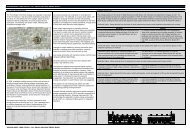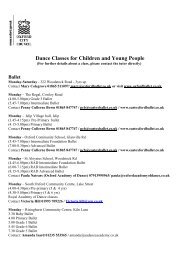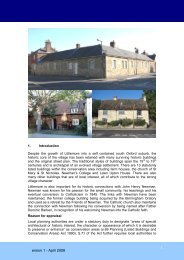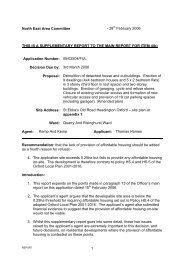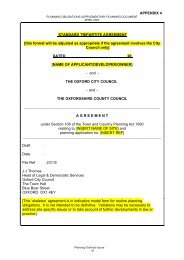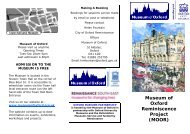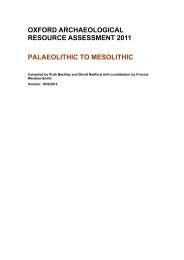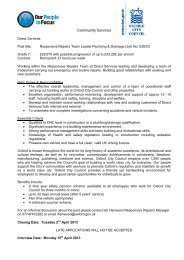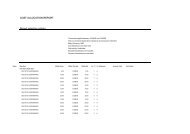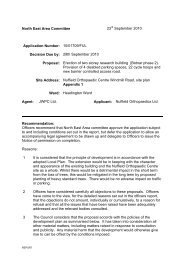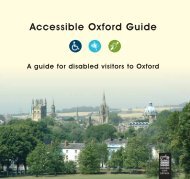Post-medieval Oxford - Oxford City Council
Post-medieval Oxford - Oxford City Council
Post-medieval Oxford - Oxford City Council
Create successful ePaper yourself
Turn your PDF publications into a flip-book with our unique Google optimized e-Paper software.
Trade and industry<br />
The principal crafts and industries of the county are summarised in an early volume<br />
of the Victoria County History (VCH ii). In <strong>Oxford</strong>, <strong>medieval</strong> trades continued with the<br />
production of woollen and leather goods, the processes of milling and malting, brick<br />
and tile manufacture and wood-based crafts. Also, stone-quarrying and masonry<br />
(Arkell 1947; Oakeshott 1975) were connected with the university and with churchbuilding<br />
or repair (Rhodes 2006). Important post-<strong>medieval</strong> additions to these<br />
industries were paper-making (Carter 1957) and printing (Barker 1979) associated<br />
with the growth of the University. Other new industries included specialist weaving<br />
such as silk (VCH ii: 227, 252), and an intensification of clock making particularly in<br />
<strong>Oxford</strong> (Beeson 1962).<br />
Markets and fairs<br />
Street markets and the Covered Market<br />
<strong>Oxford</strong> Covered Market was built in the late 18 th century to replace the proliferation of<br />
market stalls that impeded access along the main streets. Street markets by this<br />
point still retained their <strong>medieval</strong> patterns with certain trades based in certain streets<br />
such as in Fish Street (St Aldates) and Butcher Row (Queen Street). In 1771, the<br />
<strong>Oxford</strong> Mileways Act was passed in order to make the main city roads free and clear<br />
for transport. The commissioners in charge of bringing this about set about creating a<br />
new market space but they also demolished the remaining city gates, widened<br />
existing roads and on occasion created new roads (ibid.). The covered market, built<br />
in 1772, has been the subject of a detailed study by Graham (1979: 81). For a<br />
summary of the development of the market and subsequently retail shopping in<br />
<strong>Oxford</strong> see Crossley, Day, and Cooper (1983).<br />
Butchers and the butchers shambles<br />
A shambles was built in Queen Street, known as Butchers' Row, in 1556 (UAD 1356,<br />
1358). Butchers were forbidden to sell meat elsewhere except on market days. The<br />
building was extended in 1636, burnt down in 1644 and rebuilt in 1656. When the<br />
covered market opened in 1773, the shambles was demolished (VCH iv). The<br />
Butchers Guild of 1536 had ceased to be effective by the 17 th century and the city<br />
controlled the Butchers Row in the markets. In 1703, the city approved an<br />
incorporation of butchers and poulterers effectively replacing the earlier guild (VCH<br />
iv: 317). A well recorded in Queen Street in 1973 may have been used by the<br />
butchers (UAD 752). A 16 th -early 17 th century pit at 31-34 Church Street produced<br />
tentative evidence for butchery waste (Hassall, Halpin and Mellor 1984).<br />
Guilds<br />
<strong>Oxford</strong> was never a large enough town to have a large number of long-established<br />
gilds and companies, though a few could boast a long history. The situation was also<br />
confused by the university‘s licensing of traders as ‘privileged persons’ protected by<br />
university statues (and courts) rather than being subject to secular control, and this<br />
long remained a source of friction between town and gown.<br />
The cordwainers remained on Northgate Street eventually building a new guildhouse<br />
adjacent to the Bocardo, known as Bocardo House or Shoemakers Hall (Crossley et<br />
al. 1979: 314). The guild continued to operate until 1849, however its fortunes and<br />
influence had long since dwindled (ibid.: 315). By the early seventeenth-century, the<br />
<strong>Oxford</strong> leather industry was widely renowned, particularly the making of saddles. Two<br />
pieces of leather recovered from the Castle moat were worked (in this instance seal<br />
OXFORD ARCHAEOLOGICAL RESOURCE ASSESSMENT- POST MEDIEVAL<br />
32



